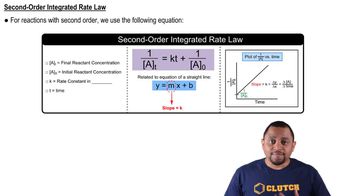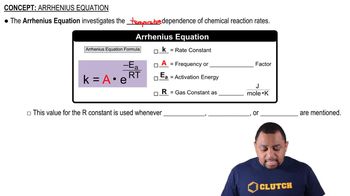The rate constant (k) for a reaction was measured as a function of temperature. A plot of ln k versus 1/T (in K) is linear and has a slope of -7445 K. Calculate the activation energy for the reaction.

The tabulated data were collected for the second-order reaction: Cl(g) + H2(g) → HCl(g) + H(g). Use an Arrhenius plot to determine the activation barrier and frequency factor for the reaction. Temperature (K) and Rate Constant (L/mol # s) are as follows: 90 K, 0.00357; 100 K, 0.0773; 110 K, 0.956; 120 K, 7.781.
 Verified step by step guidance
Verified step by step guidanceKey Concepts
Second-Order Reactions

Arrhenius Equation

Activation Energy

The data shown here were collected for the first-order reaction: N2O(g) → N2(g) + O(g) Use an Arrhenius plot to determine the activation barrier and frequency factor for the reaction.
Temperature (K) Rate Constant (1 , s)
800 3.24⨉10- 5
900 0.00214
1000 0.0614
1100 0.955
The tabulated data show the rate constant of a reaction measured at several different temperatures. Use an Arrhenius plot to determine the activation barrier and frequency factor for the reaction.
Temperature (K) Rate Constant (1 , s)
300 0.0134
310 0.0407
320 0.114
330 0.303
340 0.757
A reaction has a rate constant of 0.0117/s at 400.0 K and 0.689/s at 450.0 K. a. Determine the activation barrier for the reaction.
A reaction has a rate constant of 0.000122/s at 27 °C and 0.228/s at 77 °C. b. What is the value of the rate constant at 17 °C?
